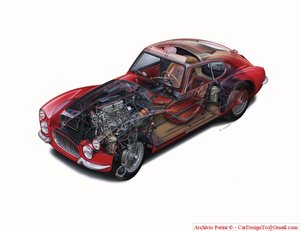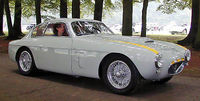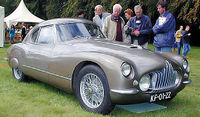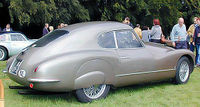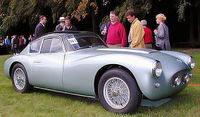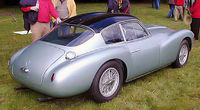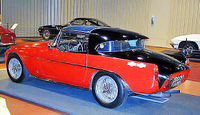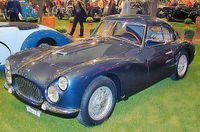Fiat 8V
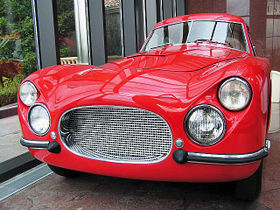
| |
| Fiat 8V | |
|---|---|
| Manufacturer | Fiat |
| Production | 1952-1954 |
| Successor | Fiat 850 |
| Class | Sports car |
| Layout | FR layout |
| Body style | 2-door coupe |
| Engine | V8 1996 cc |
| Transmission | 4 and 5-speed manual |
| Wheelbase | 240 cm |
| Length | 406 cm |
| Width | 150 cm |
| Height | 126 cm |
| Weight | 1000 kg |
Fiat 8V Zagato
| |
The Fiat 8V (or "Otto Vu") is a sports car produced by the Italian automaker Fiat from 1952 to 1954. The car was introduced at the 1952 Geneva Motor Show. The name 8V was chosen because they thought that Ford had trademarked the name "V8". Only 114 cars were made in a few different versions. They weren't a commercial success, but did well in racing. Apart from the differential the car did not share any parts with the other Fiats (but many parts were made by Siata and they used them for their cars). The 8V was developed by Dante Giacosa and the stylist Fabio Lucio Rapi. The engine was a V8 originally designed for a luxury sedan, but that project was stopped. The Fiat V8 had a 70 degree V configuration of up to up a 1996 cc of volume, at 5600 rpm the engine produced 105 hp in standard form giving a top speed of 190 km/h. The engine was connected to a four speed gearbox. The car had independent suspension all round and drum brakes on all four wheels.
34 of the cars had a factory produced bodywork by Carozzeria Speciale FIAT. Some cars had the bodywork done by other Italian coachbuilders. Carozzeria Zagato made 32 that they labelled "Elaborata Zagato". Ghia and Vignale also made bodyworks. Most were coupés, but some spyders were made as well.
Excellent write up from RitzSite.nl
There are cars which are so rare and unique that only real enthusiasts are aware of their existence. A good example of that is the Fiat 8V, or in Italian: Otto Vu. Fiat is best known for its affordable mass produced cars and not many people associate this manufacturer with exotic sports cars. But connoisseurs know of this small series of exiting thoroughbred competition sports cars which left huge Fiat factory during 1952-1954.
Only 114 8V models were produced and these cars were not a commercial success, but in sports car races they were highly competitive and credited with many victories. This, and the fact that the cars were fitted with some of the best and most beautiful bodywork designs from that era, ensured that the 8V became an instant classic, cherished by its owners. And so, remarkably, almost all produced 8V models are still in existence. Most of these cars have a well documented history and fetch exorbitant prices at classic car auctions.
A large portion of the 114 produced 8Vs were fitted with a factory produced bodywork: Carozzeria Speciale FIAT. The car on this picture shows the first series of this type of bodywork, which can be identified by the two headlights in the grille.
The 8V was a completely new and innovative car which was introduced at the 1952 Geneva Motor Show. Apart from the differential all parts were specially designed for this car. The lightweight self-supporting bodywork was constructed out of thin-gauge steel panels in the form of two bearing shells: the outside shell provided the shape and combined with the inside shell a load-bearing box-section structure was created. It had a very aerodynamic shape which was tested in a wind tunnel; very advanced for that time. Even the rear wheel spats contributed to reducing drag and increased the top speed by 4 kph.
The Fiat 8V was developed by Dante Giacosa and stylist Fabio Lucio Rapi. It was based around an 8-cylinder engine in V-configuration which was originally designed by Fiat for a luxurious sedan, the successor to the pre-war Ardita models. After the engine had been finished the Fiat management decided to stop the project and not to enter this market segment (something they failed to do successfully ever since). Fortunately this advanced engine was not shelved. The Fiat management wanted to boost the company's image and presenting an exclusive and competitive sports coupe seemed an attractive option. And so the team around Giacosa set out to create this car and of course they used the most advanced engine Fiat had available at the time: the only V8 Fiat ever built.
The most important supplier of alternative bodywork for the 8V was Carozzeria Zagato. Zagato bought 32 complete 8V chassis from Fiat; four of those already had some portions of the original bodywork installed. These were modified with an aluminum roof and revised windows which were appended to the face-lifted lower steel bodywork. The cars which received this treatment became known as "Elaborata Zagato", and the car shown here is one of them.
But also Ghia and Vignale fitted most stunning designs on the Fiat 8V chassis. A true design classic of these is the Berlinetta Savonuzzi by Ghia, a streamlined coupe which was very influential on modern car design. There were also a small number of 8V spiders, small open top sports cars, constructed. Those are really the white ravens in car history...
If you look at this car now, it doesn't seem so special. It's of course a wonderful car with a classic Italian sports car shape, but somehow familiar. But now imagine that it was designed in 1952, a time in which car designers had just dismissed winged fenders and were experimenting with aerodynamica. Then you'll understand that this design was quite avant-garde at the time and a trend-setter for what we now call a classic Italian Gran Turismo.
This car features Zagato's design trademark: the "double-bubble" roof: the roof surface has two "humps", one above the driver's and one above the passenger's head. It was optional and more or less a gimmick, but also gave some extended head room and the construction was a bit lighter and more rigid. The car on these pictures (chassis number 081) has an extensive rally and racing history.
Zagato fitted 28 Fiat 8V chassis with completely new bodywork. All of them featured lightweight aluminum bodies. These cars were often used in competition and were quite successful in road races like the Targa Florio and the Mille Miglia.
Not at all a classic sports car shape have this 8V with bodywork by carozzeria Vignale. It looks like a show car but it is actually a race car which is still entered in events like the Mille Miglia in Italy.
Vignale has fitted a small number of Fiat 8Vs with bodywork; often very original angular designs which need some getting used to. This car is the most famous of them. Because of its sharp, slightly angry design and of course the distinctive red and black paint job it became known as the "Demon Rouge": the Red Demon.
The rear of this cars shows also some original styling elements, like the panoramic rear window and the extended roof line, sculpted like a visor. Also note the finned shape of the rear fenders, which wasn't at all common then. American cars started to have "tail fins" from the 1955 model year, about 3 years after this car was introduced. European main stream cars got them even later.
This car may not be aesthetically beautiful, its aerodynamic design is certainly impressive and made a big impact in 1952, being not alike any other car.
After the first 34 cars with Fiat factory body its design was revised. Now both pairs of headlights were fitted in the front wings in a slanted layout (with headlight positions compliant to GT-category regulations) and the grille was less ostentatious. Also the rear wheel spats disappeared. The car still had a remarkable, original style, but now looked a bit more harmonious. This model became known as the second series 8V.
The V8 engines in these Fiats were nothing like their American counterparts. These units were compact, high revving and had a small displacement. The 8 cylinders were fitted in a 70 degree V configuration and combined they measured up a 1996 cc displacement. In standard trim the unit produced 105 hp @ 5600 rpm, enough to power this 996 kg car to a maximum speed of 190 kph. Torque was a limited 149 Nm @ 3600 rpm.
Because this was in essence a competition car there were also tuned versions, which had special camshafts and higher compression. With the original 2 double Weber carburetors fitted these tuned versions produced 115 hp @ 6500 rpm (typical for the second series 8V). There was also a rare competition engine which featured 2 four barrel Webers and special cylinder heads with four separate intake ports. These engines were rated at a maximum of 125 hp. Since the engine was originally designed for a luxury car the crankshaft only had 3 main bearings, so driving it at high revs was a bit risky.
External links
| <- Older Models | Fiat car timeline, European market, 1920s-1960s | Next -> | ||||||||||||||||||||||||||||||||||||||||||||||||||
| Type | 1920s | 1930s | 1940s | 1950s | 1960s | |||||||||||||||||||||||||||||||||||||||||||||
| 0 | 1 | 2 | 3 | 4 | 5 | 6 | 7 | 8 | 9 | 0 | 1 | 2 | 3 | 4 | 5 | 6 | 7 | 8 | 9 | 0 | 1 | 2 | 3 | 4 | 5 | 6 | 7 | 8 | 9 | 0 | 1 | 2 | 3 | 4 | 5 | 6 | 7 | 8 | 9 | 0 | 1 | 2 | 3 | 4 | 5 | 6 | 7 | 8 | 9 | |
| City car | Fiat 500 | |||||||||||||||||||||||||||||||||||||||||||||||||
| 500 Topolino | 600 | |||||||||||||||||||||||||||||||||||||||||||||||||
| 509 | 508 Balilla | 1100 Balilla | 850 | |||||||||||||||||||||||||||||||||||||||||||||||
| Small family car | 1100 / 1200 | 124 | ||||||||||||||||||||||||||||||||||||||||||||||||
| 501 / 502 | 503 | 514 | 515 | 1500 | 1400 | 1300 / 1500 | 125 | |||||||||||||||||||||||||||||||||||||||||||
| 518 Ardita | 1900 | |||||||||||||||||||||||||||||||||||||||||||||||||
| Large family car | 505 | 507 | 520 | 521 | 522 | 527 | 1800 / 2100 | |||||||||||||||||||||||||||||||||||||||||||
| 510 | 512 | 525 | 524 | 2800 | 2300 | 130 | ||||||||||||||||||||||||||||||||||||||||||||
| 519 | ||||||||||||||||||||||||||||||||||||||||||||||||||
| Luxury car | 520 | |||||||||||||||||||||||||||||||||||||||||||||||||
| Sports car | 8V | Trasformabile | Dino | |||||||||||||||||||||||||||||||||||||||||||||||
| MPV | 600 Multipla | 850 Familiale | ||||||||||||||||||||||||||||||||||||||||||||||||
| SUV | Campagnola | |||||||||||||||||||||||||||||||||||||||||||||||||
